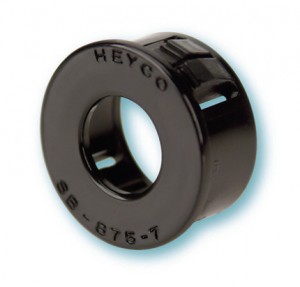 Bushings are used to protect both wires and the machines and surfaces that they pass through. To protect wires, bushings insulate openings for the wires to pass through so they won’t be damaged in any way. This insulation also prevents short circuits and damage to machinery by keeping wires separated from each other. High voltage passing through the wires can cause such damage.
Bushings are used to protect both wires and the machines and surfaces that they pass through. To protect wires, bushings insulate openings for the wires to pass through so they won’t be damaged in any way. This insulation also prevents short circuits and damage to machinery by keeping wires separated from each other. High voltage passing through the wires can cause such damage.
There are many different types of bushings that can be used to protect wires, which can cause confusion unless you have years of experience dealing with bushings. So, here’s some general information about the various types of bushings.
Snap Bushings
Snap bushings take raw-edged holes and convert them to smooth insulated holes. They are used to insulate and protect cables, utility lines, and tubes among other things. They’re very easy to install as the bushing snaps together with only pressure from your fingers.
Thin Panel Bushings
Thin panel bushings are actually a subset of snap bushings. They snap together just like snap bushings. The only major difference is that they’re designed specifically for – you guessed it – thin panels. If you need to pass wires, cables, utility lines, or anything else through a panel that is less than half a millimeter thick, then these are the bushings you should go with.
Universal Bushings
Universal bushings have an added feature. They include flexible “shutters” for wires to pass through. These shutters act to absorb any vibration caused by machinery attached or adjacent to the bushing. They also cushion whatever passes through the bushing. At the same time, they still insulate and protect both the machinery / surface and the wire, cable, line, tube, or whatever is passing through the surface via the bushing.
Threaded Bushings
Threaded bushings take raw-edged threaded pipe ends and convert them to smooth insulated holes. In every other way, they are the same as snap bushings.
Smooth Bore Bushings
These bushings, similar to threaded bushings, convert threaded holes to smooth insulated holes. Their primary function is to eliminate sharp edges. So if you know your wires will be passing through material with very sharp edges, consider these bushings. They also include an extra internal layer of insulation and absorb vibration while cushioning and insulating whatever passes through it.
Liquid Tight Bushings
These bushings should only be used in situations where you need to create a liquid tight seal around what will be passing through the bushing. They are simple to install and weather resistant.
Those are the major categories of bushings. They all share one main purpose – protecting what passes through them and protecting the surface that is being passed through. They do this by creating smooth surfaces, eliminating sharp edges, absorbing vibration, preventing short circuits, and providing cushion. Depending on what surface you’ll be installing the bushing on – it’s size, type, etc. – you’ll need to choose the appropriate bushing type. With the information above, you can now do that confidently.
